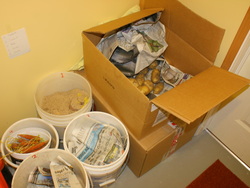
How did we build the root cellar? When we finished the basement, the most important planning went into Kevin’s music studio called “The Cave”. Kevin designed thick walls to insulate his studio from the furnace room noise. I wanted a small area of the basement for food and other storage. The most practical place, considering his space needs for the studio, was the corner with an existing utility sink and window. We insulated and finished all outside walls and had to build two super insulated walls and set in a door. Kevin also built a type of baffle that can be placed in the window frames to keep out bitterly cold air or hot summer heat.
How does it work? The root cellar is not heated and the window can be opened to cool it down. In -20 degree weather, the inside temperature with windows closed (but without the baffle) is around 6 degrees Celsius. Recommended long-term storage temperature for potatoes is 7-10 degrees Celsius. Below 7 degrees, potato starch can convert to sugar.
What are the challenges? Our root cellar is located on the south side of the house and we have not yet insulated the door. This made it very difficult to cool the room down enough in fall and this past month with the warm weather. I have had to open and close the window quite frequently and keep an eye on the temperature. Fortunately, I have a digital thermometer that I can monitor from the kitchen. Once we insulate the door, the temperature should be more stable. Ideally, the root cellar would be located on the north side of the house.
How do I store vegetables in the root cellar? In previous years, I kept my potatoes in buckets of garden soil. However, when my community garden potatoes were affected with late blight, I did not want to bring infected soil to my home and garden. Since then, I have been storing my potatoes in cardboard boxes between layers of newspaper. If any of the tubers start to rot, they newspaper layers will prevent the spread of disease somewhat.
I also stored some carrots in soil last year, but this winter I wanted to try storing veggies in buckets of sand. I got some play sand from a landscaper and layered my carrots, tops cut off and soil rubbed off, with sand in a bucket. I did the same with beets and turnips. I moistened the sand very lightly and to retain the moisture, I placed newspaper on top of the sand. Once in a while, I remoisten the top of the bucket. The veggies have fared very well, although some carrots have tried to sprout, likely because of warmer temperatures. The sand can make quite a mess and I have to rub it off carefully before taking the veggies to my sink for rinsing.
2016 Update: Carrots and beets stored in plastic bags with a large piece of paper towel seems to work best, as long as the root cellar is about 5 degrees C. Veggies that are caked with soil don't do well, so in a wet fall, it's important to cut off the tops, wash the produce, let it dry and then store it in plastic bags with paper towel to absorb excess moisture. Check the bags once in a while to catch any produce that may have spoiled or wants to grow.
Kevin Kossowan also experimented with this and found that his carrots and beets lasted longer washed and stored in plastic bags. Check out Kevin’s website for great info on root cellaring and more.
 RSS Feed
RSS Feed